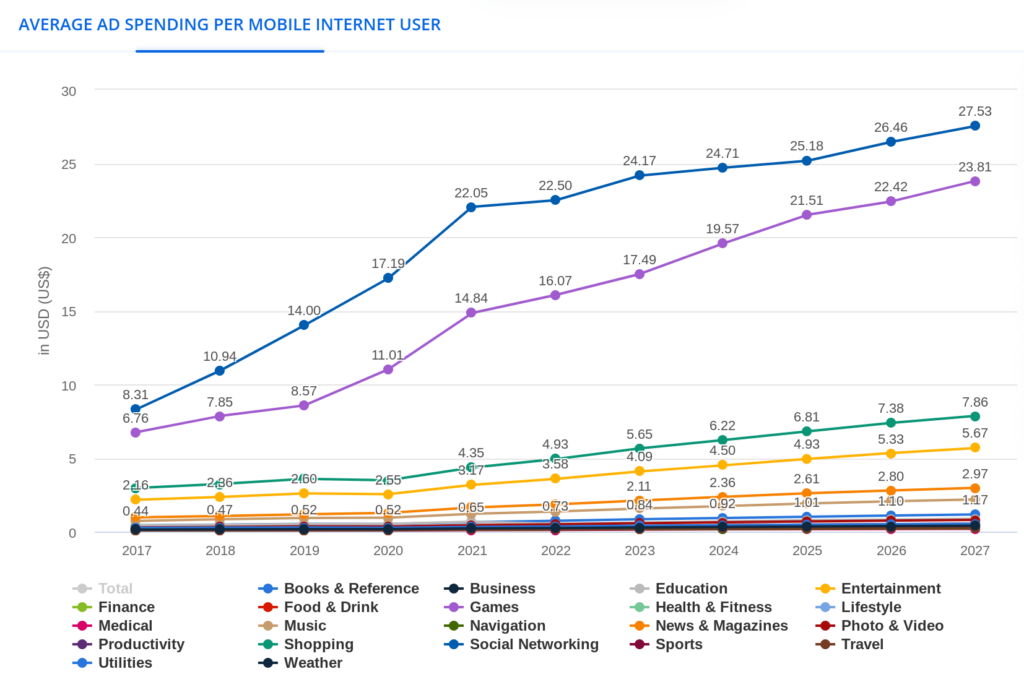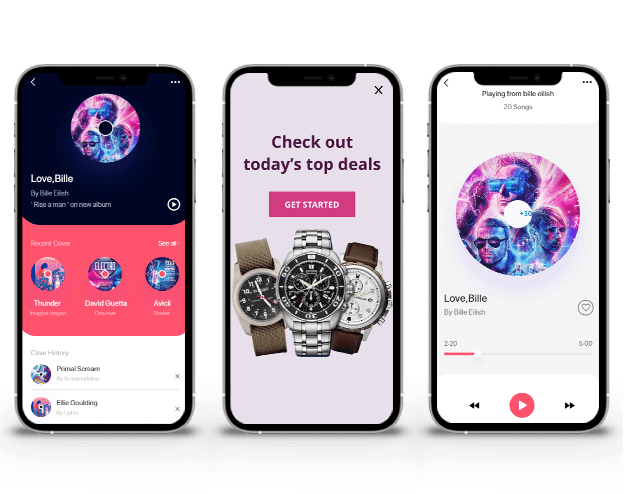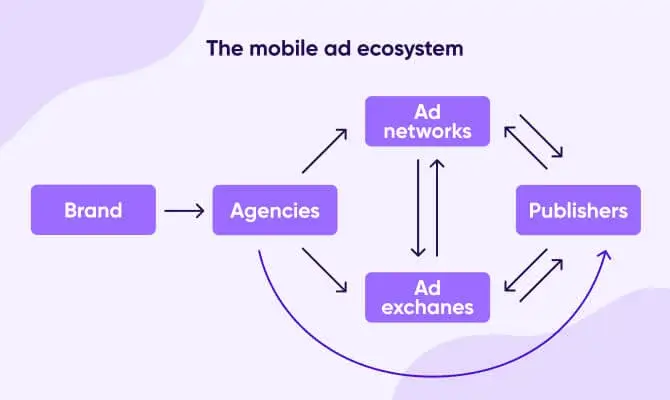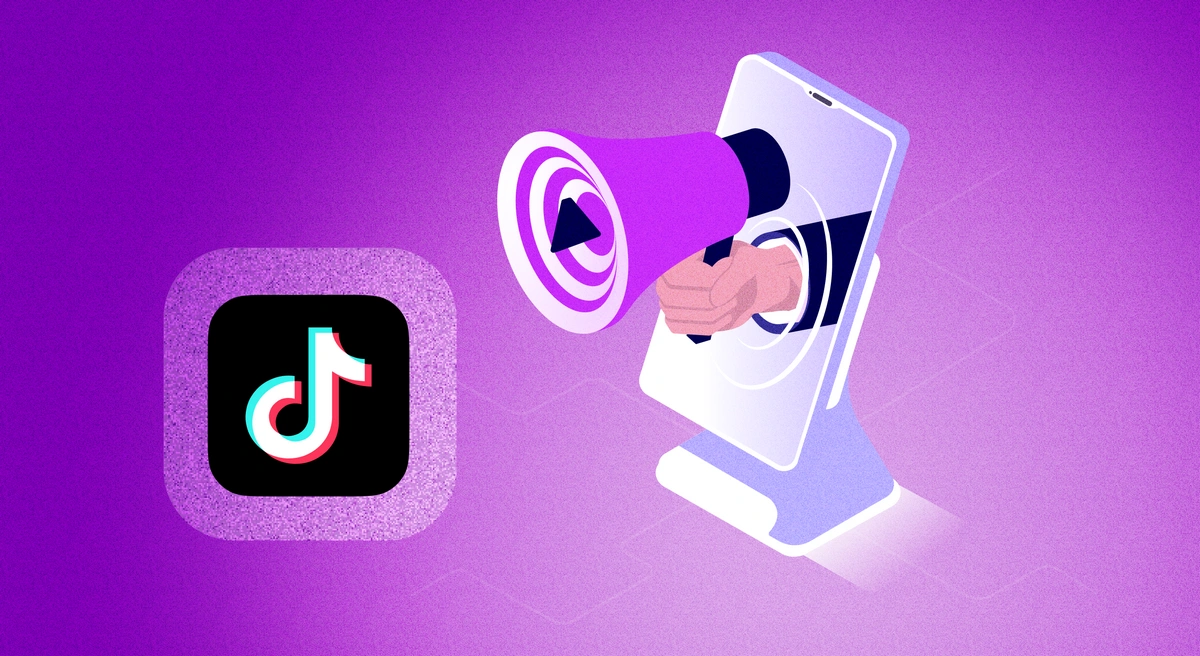Projected to reach $495 billion by 2024, mobile advertising is one of the fastest-growing channels in the mobile marketing mix. In fact, mobile advertising – which covers all the ads you see on your phone, from in-app ads and sponsored posts in your social media feeds to SMS advertisements – gets a whopping 64% of all digital ad funds.
As consumers spend more time on their phones, businesses are trying new and innovative mobile advertising ways to connect with them. They’re tapping improved personalizations, targeting, and AR/VR capabilities, among others, to deliver more relevant and immersive mobile ad experiences.
But what exactly is mobile advertising? What are the latest trends shaping this rapidly evolving landscape? And what lies ahead for mobile advertising in 2024 and beyond? Let’s find out. While we’ll discuss mobile advertising in general in this article, we’ll focus more on in-app mobile advertising (as that’s your share in this growing mobile advertising market!). In-app advertising – or showing ads inside apps – is an increasingly popular mobile advertising method, and globally, 36% of apps use in-app advertising for generating revenue.
Here goes.
What is mobile advertising?

Simply put: Mobile advertising is showing ads to users on mobiles. Mobile advertising is a subset of mobile marketing focusing on promotions using paid ads. Mobile marketing, in contrast, is multi-channel marketing that encompasses all the channels a business uses to reach, convert, and engage its target mobile traffic. Mobile marketing includes everything from mobile-friendly websites and SMS marketing to app-based marketing.
Given how businesses can reach users via phones, mobile advertising takes many forms. Take mobile search result ads, for instance. When a user makes a search on their phone’s browser, search engines show ads along with the organic results. Ads (or sponsored posts) appearing when you browse social networks like Facebook or Instagram are also examples of mobile advertising. Ads you see on any mobile website also count toward mobile advertising. Video advertising – of which YouTube advertising is a huge part – is also a mainstream part of mobile advertising. Yet another form of mobile advertising is in-app advertising. Here, advertisers show ads to app users.
In other words, all ads on mobile count toward mobile advertising. Let’s now take a closer look at the current state of the mobile advertising landscape and explore some projections for 2023 and beyond.
The state of mobile advertising in 2024
As noted above, mobile advertising has grown steadily over the last few years – it’s already surpassed the 327.1 billion U.S. dollars global milestone. As more and more marketers shift their digital ad spend toward mobile, this is only set to increase.
Within mobile advertising, in-app advertising, too, has experienced significant growth. Statista’s report on in-app mobile advertising underscores the upward trajectory of this channel. For the sake of this article, we’ll focus more on in-app advertising as it can help you unlock untapped revenue and effectively monetize your non-spending app users without compromising the revenue generated from in-app purchases.
In its latest in-app advertising research, Statista estimates in-app advertising to hit 462.30 billion in 2027. This projection includes mobile advertising on social media apps like Facebook and Instagram (which take the majority of the spend actually). But even if you leave that out, app store apps like yours, too, can build an additional revenue stream with advertising.
“As more companies become aware of the possibility of reaching audiences through mobile applications, the market for in-app advertising is now booming and is expected to continue expanding. Given that in-app advertising allows advertisers to target particular audiences based on their activity, preferences, and location, it is one of the most successful types of mobile advertising. According to analysts, in-app advertising will continue expanding as more companies shift their advertising budgets to mobile.” – Statista

Let’s also talk about mobile ad spending. According to Statista, apps across all verticals are seeing increased ad spending, and the trends are expected to hold well into the future. While the social media and games niches dominate the in-app advertising market, apps across all categories show significant growth in ad spending:

In its 2022 report, Grand View Research, Inc. also estimated in-app advertising to cross the $410 billion mark by 2030.
In another research on mobile ads, the market research firm Market Research Future (MRFR) projected in-app advertising to grow at a CAGR of 17.32% and hit USD 312.48 billion by 2030.
And according to Verified Market Research., the in-app advertising market is projected to grow at a CAGR of 19.96% and is expected to hit USD 544.93 billion by 2028.
Even considering the deviance in projections, the upward trend is clear: in-app advertising is growing, and mobile marketers are looking to tap into the reach of apps. And there’s ad revenue to be made in all kinds of app niches. It doesn’t matter if you run a productivity app or a health and fitness app. Adding ads to your app monetization mix can build you a sustainable revenue channel.
So how does in-app mobile advertising actually work? Before we see how in-app advertising works, let’s see the three key ways in-app advertising works for app makers. There’s more than just revenue to be made.
Benefits of in-app advertising for app businesses
Revenue
Many free and freemium apps – that make the majority of the apps in the Android and iOS app stores – rely on ads. Also, studies from ad networks show that adding ads to apps actually helps get more in-app purchases. When Avid.ly, a Chinese app business, was looking to add another revenue stream to “supplement the revenue it received from the typically small percentage of players who were buying digital goods,” it added ads to its app. While Avid.ly was concerned about losing a share of their in-app purchases due to introducing rewarded ads, it observed the opposite. In-app sales increased by 18%, while the total revenue grew by 40%.
Better engagement
If you can deliver engaging ad experiences that are relevant and personalized and are delivered in a way they don’t get in the way of your app users, they won’t mind them. Users don’t mind when ads help an app stay free – they’d rather watch ads than pay for apps. That explains why avoiding ads isn’t the top reason that free or freemium app users upgrade to premium plans.
When done right, ads can even enhance your app users’ experience. For instance, if you use rewarded ads to monetize your app, you can engage your users better as they’ll see the incentive for watching them or engaging with them, thereby getting you more ad revenue and your advertisers higher exposure.
You’ll be surprised to know that users actually like rewarded ads. Google’s internal studies have found that 50% of users would report lower satisfaction with their app experience if rewarded ads were removed. This particular ad format is “a completely acceptable advertising format,” even according to Statista’s research.
More in-app purchases
Again, if you add formats like rewarded ads to your app monetization mix, you can let your users access features of your app that are only available via in-app purchases. Such previews and trials of premium features or functionalities boost in-app purchases. In fact, according to ironSource, users that engage with rewarded ads are 4.5X more likely to make in-app purchases.
Let’s now zoom in on the mobile advertising ecosystem.
The mobile advertising ecosystem
The mobile advertising ecosystem can be very complex and involves various stakeholders:
Advertisers
Advertisers are brands that want to promote their products and services through apps. Despite the growth of in-app advertising as a mobile advertising channel, it’s not the primary choice for mobile marketers. Search, video, and social networks continue to dominate as the most popular advertising avenues, although regional variations exist.
Publishers
Publishers are apps that publish advertisers’ ads. Android and iOS platforms let you put up multiple ad slots inside your app(s) and sell them. Both also support various ad formats, from video ads to interstitials.
Mobile ad networks
Mobile ad networks are platforms where advertisers and publishers buy and sell ad inventory. How does it work? A mobile ad network maintains a “network” of advertisers and publishers. When an advertiser gives their audience targeting criteria, the ad network matches it to find publishers (apps) that cater to the same demographics. As you can see, the ad network is an intermediary that sells its publishers’ pre-packaged ad inventory to its advertisers. Ad networks are more of a “service provider” than a technology platform. While ad networks manually match publishers and advertisers, they may use programmatic (automated) advertising for the same.
Mobile ad exchanges
In contrast to mobile ad networks, mobile ad exchanges are technology platforms that let advertisers and publishers work together directly. Here advertisers and publishers work directly to buy and sell advertising space through real-time auctioning – there’s no intermediary. How does it work? With ad exchanges, publishers sell their ad inventory via the ad exchange’s auctioning system. At all times, advertisers have full visibility into the available ad inventory and place bids in real-time for securing ad placements on publishers that reach their target audience.
While we’re at it, let’s also talk about Supply-Side Platforms and Demand-Side Platforms. Supply-side platforms help publishers sell their ad slots via a host of ad networks and exchanges to reach more advertisers, get better revenue for their ad inventory, and ensure that their ad slots get filled.
Demand-Side Platforms, in contrast, connect an advertiser with a host of ad networks, ad exchanges, and publishers so they can reach more publishers (and users!) and get more competitive ad placements and better ROI for their advertising campaigns. Simply put, with SSPs and DSPs, you aren’t working exclusively with a single ad network, exchange, or publisher/advertiser.
App analytics solutions
Third-party mobile app analytics solutions are also a part of the in-app advertising mix. Take Adapty, for example. Adapty offers you the infrastructure you need to sell in-app purchases inside your iOS and Android apps. Passing this data to an app analytics solution like AppsFlyer, for example, can help you understand your actual user LTV when you’re using a hybrid monetization model that includes both ads and in-app purchases.

Over time, these tools and integrations help you discover what your actual customer lifetime value is and how you can improve it. Also, because a user’s in-app purchases give great insight into their interests, you can pass this data to your ad network via intermediary services, like AppsFlyer, to serve even more relevant ad experiences. You get the drift.
Mobile measurement platforms are also a key part of the mobile advertising mix as they help advertisers understand what mobile marketing channels work best for them.
Let’s now discuss the top ad formats that you can use to add ads to your app.
Mobile ad types
Android and iOS support various ad types to help you monetize your app. Here are the main ones.
Text, image & rich media ads
These ads can be anything from simple text ads, image ads (static or animated like a GIF), and rich media ads that can use elements like text, images, and interactivity components.
Video ads
Video ads are one of the best-performing ad types for in-app advertising. Unless users unmute them, video ads in banner ad formats are muted by default.
Interactive ads
Interactive ads are ads that users can interact with. For example, these can be playable ads that users can tap to watch or ads with elements like surveys.
Mobile ad formats
Here’s a quick view of the ad types that you can fit in the above ad formats.
Banner ads
Easily the most ubiquitous form of in-app ads, banner ad slots are placed at the top or bottom of app screens. They can also be placed inline. If you want to try banner ads, you need to design user interfaces that can accommodate banner ad slots. While these ads typically come in fixed sizes, adaptive banners are here to change this.
Interstitial ads
Interstitial ads are somewhat intrusive as they pop up when a user is engaging with an app. They cover the entire user screen and cause a “break” in the app flow. For this reason, it’s best to place these ads when users are transitioning to, say, a new level in a game. These ads are also good to use before or after loading screens.

Native ads
Native ads are ads that match the look and feel of an app. They’re non-intrusive and designed so they feel organic in the app flow, although they’re clearly labeled as ads.
Rewarded ads
Rewarded ads offer app users a “reward” in exchange for watching or engaging with an ad. Both advertisers and users love rewarded ads as users get incentives in exchange for watching while advertisers get a good exposure.
Other than these, you also have ad types like app open ads that show up when an app is loading.
Trends and opportunities for publishers in mobile in-app advertising in 2023 (and beyond)
Pivoting to the hybrid app monetization model
The widespread acceptance of ad formats like rewarded ads make the hybrid app monetization model a winner. So if you’re on the fence about adding ads to your app monetization mix, this is a good time, as even users are fine with ad formats like playable ads and banner ads.
You don’t even need to worry about in-app purchase revenue cannibalization, as these ads only boost your in-app purchases while driving ad revenue and user engagement.
Facilitating personalizations and targeting
Collecting quality data on your users can be a great way to earn more with mobile in-app advertising, as advertisers want to offer targeted and personalized advertising – which is only possible with data. So focus on building zero-party databases. When you onboard your new mobile app users, try to learn more about them.
Analyze behavioral data too. Use app analytics solutions like Hotjar to see how your users behave inside your app. Learn about the content, features, or functionalities they find the most engaging.
Also, collect transactional data. Use app revenue analytics tools like Adapty to understand your users’ buying behavior.
With data, you can also sell your ad space directly to advertisers and collaborate on even more engaging ad experiences – a win for everyone: you, your users, and advertisers.
Adding experimentation to the in-app advertising mix
There are various ways experimentation can help you monetize your app better with ads. For example, as an app publisher, you get to decide what ”incentives” you want to offer to your users when it comes to rewarded ads. So experiment with different incentives to find the ones that perform the best.
You can also experiment with ad formats to see which ones your users engage with the best – even native ads can do surprisingly well. Ad placements are another area you can optimize with testing.
When it comes to in-app advertising, you also need to factor in things like seasonalities. Running growth experiments around these can also help you maximize these opportunities.
Key challenges in mobile in-app advertising

Balancing ads with user experience
When done right, ads don’t have to cause a bad user experience. However, weaving in-app advertising into an app experience so it feels non-intrusive is tricky. A good starting point is to consider the number of ads you intend to show a user during a session, how often they’ll appear, and their formats.
Addressing privacy concerns
With the newer digital privacy lines, users are much more aware of what data they let an app access, how it processes it, and if it’s shared with other particles (like ad networks). While the in-app advertising ecosystem needs you to transfer data, conveying these to users can be a challenge. Using good ATT prompts is crucial. Also, look for privacy-friendly solutions for collecting and managing your user data. Maintaining transparency about your data practices is the best approach here.
Building a zero/first-party database
One of the main reasons that drives advertisers to mobile advertising is its targeting capabilities. Apps can take targeting to a whole new level as they can collect zero-party data. Many apps actually collect this. One downside, though, is that users can be unwilling to share their data.
Handling ad fraud
Ad fraud is a common concern for advertisers – and it’s present even with in-app advertising. False impressions (by loading ads but not actually displaying them), ad stacking (loading multiple ads where only the top one is actually visible), and fake clicks are some common malpractices. Publishers experience another kind of ad fraud – mainly coming from unethical advertisers.
Handling ad blockers
While both the app stores prohibit blocking in-app ads, you do have ad blockers that can block in-app ads. That said, since these aren’t available from the app stores and often require access to the phone’s root, blocking in-app ads via ad blockers isn’t so popular.
Conclusion
With the growing global app market, in-app advertising is set to take a big share of the growing mobile advertising budgets. The best part is that in-app ads can help monetize apps irrespective of their monetization model. You can add mobile ads to your app monetization mix even if you offer in-app purchases or follow the subscription model. In fact, apps that pivot to the hybrid monetization model by adding ads don’t just report higher revenue by introducing ads but also see more in-app purchases.
Additionally, incorporating a few ad formats like rewarded ads allow users to access premium features without paying for them directly. This helps convert more free app users when they like the features they get to try.
Incorporating ads can also help increase user engagement and retention by offering rewards or bonuses for watching or interacting with them.
However, it’s important to consider user experience when implementing ads. Too many or intrusive ads can lead to negative reviews and decreased user retention. It’s crucial to balance monetization and providing a positive user experience.
About Adapty: Adapty lets you sell in-app purchases inside your Android and iOS apps. In addition to offering this in-app sales infrastructure, Adapty also doubles up as an app revenue analytics platform. Adapty also ships with a paywall builder that you can use to design, code, and add test paywalls with just a few clicks. Check out how Adapty can help you grow your app business.





